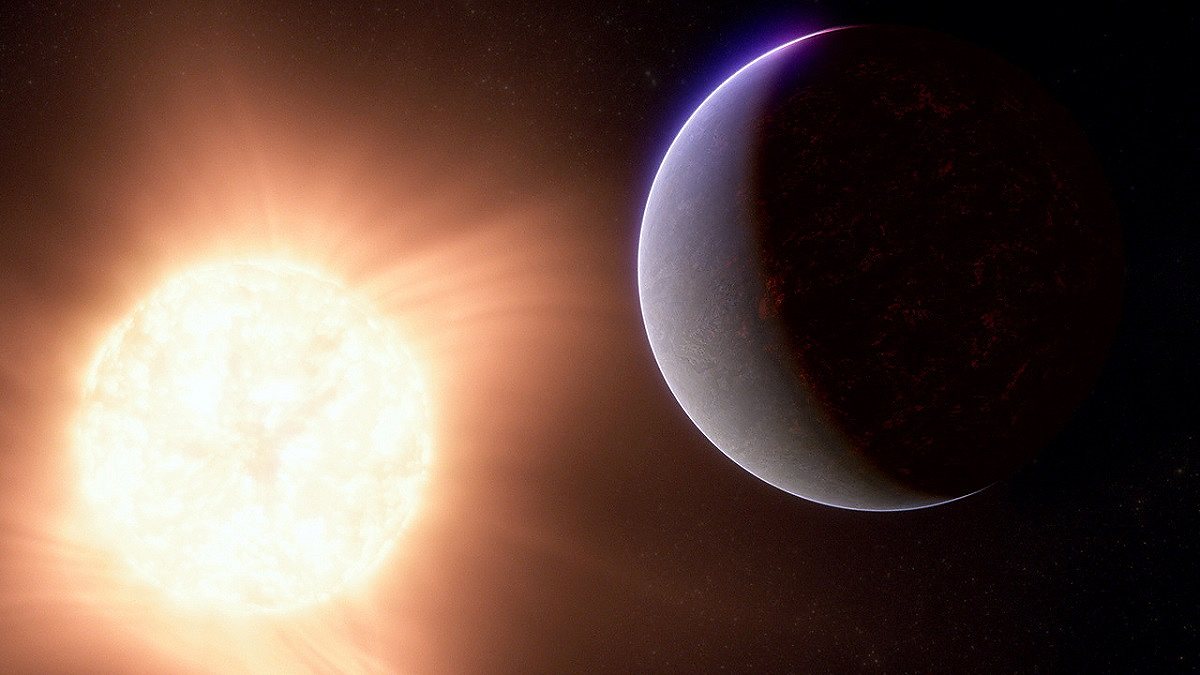
The exoplanet 55 Cancri e, also called Janssen, is seen in this undated illustration released by NASA.
17:11 JST, May 30, 2024
WASHINGTON (Reuters) — Astronomers have searched for years for rocky planets beyond our solar system with an atmosphere — a trait considered essential for any possibility of harboring life. Well, they finally seem to have located one. But this hellish planet — apparently with a surface of molten rock — offers no hope for habitability.
Researchers said on May 8 the planet is a “super-Earth” — a rocky world significantly larger than our planet but smaller than Neptune — and it orbits perilously close to a star dimmer and slightly less massive than our sun, rapidly completing an orbit every 18 hours or so.
Infrared observations using two instruments aboard the James Webb Space Telescope indicated the presence of a substantial — if inhospitable — atmosphere, perhaps continuously replenished by gases released from a vast ocean of magma.
“The atmosphere is likely rich in carbon dioxide or carbon monoxide, but can also have other gases such as water vapor and sulfur dioxide. The current observations cannot pinpoint the exact atmospheric composition,” said planetary scientist Renyu Hu of NASA’s Jet Propulsion Laboratory and Caltech, lead author of the study published in the journal Nature.
The Webb data also did not make clear the thickness of the atmosphere. Hu said it could be as thick as Earth’s or even thicker than that of Venus, whose toxic atmosphere is the densest in our solar system.
The planet, called 55 Cancri e or Janssen, is about 8.8 times more massive than Earth, with a diameter about twice that of our planet. It orbits its star at one-25th the distance between our solar system’s innermost planet Mercury and the sun. As a result, its surface temperature is about 1,725 C.
“Indeed, this is one of the hottest known rocky exoplanets,” said astrophysicist and study coauthor Brice-Olivier Demory of the University of Bern’s Center for Space and Habitability in Switzerland, using the term for planets beyond our solar system. “There are likely better places for a vacation spot in our galaxy.”
The planet is probably tidally locked, meaning it perpetually has the same side facing its star, much like the moon does toward Earth. The planet is located in our Milky Way galaxy about 41 light-years from Earth, in the constellation Cancer. A light year is the distance light travels in a year, 9.5 trillion kilometers. Four other planets, all gas giants, are known to orbit its host star.
That star is gravitationally bound to another star in a binary system. The other one is a red dwarf, the smallest kind of ordinary star. The distance between these companions is 1,000 times the distance between Earth and the sun, and light takes six days to get from one to the other.
After all their searching, the rocky exoplanet for which scientists finally found evidence of an atmosphere turned out to be one that probably should not even have one. Being so close to its star, any atmosphere should be stripped away by stellar irradiation and winds. But gases dissolved in the vast lava ocean thought to cover the planet may keep bubbling up to replenish the atmosphere, Hu said.
“The planet cannot be habitable,” Hu said, because it is too hot to have liquid water, considered a prerequisite for life.
All of the previous exoplanets found to have atmospheres were gaseous planets, not rocky ones. As Webb pushes the frontiers of exoplanet exploration, the discovery of a rocky one with an atmosphere represents progress.
On Earth, the atmosphere warms the planet, contains the oxygen people breathe, protects against solar radiation and creates the pressure needed for liquid water to remain on the planet’s surface.
“On Earth, the atmosphere is key for life,” Demory said. “This result on 55 Cnc e entertains the hope that Webb could conduct similar investigations on planets that are much cooler than 55 Cnc e, which could support liquid water at their surface. But we are not there yet.”
"Science & Nature" POPULAR ARTICLE
-

Genome Study Reveals Milestone in History of Cat Domestication
-

Big Leap in Quest to Get to Bottom of Climate Ice Mystery
-

Japan Set to Participate in EU’s R&D Framework, Aims to Boost Cooperation in Tech, Energy
-

Paws on Parade: Nairobi’s Dogs Dazzle at ‘Pawchella’
-

Japan’s H3 Rocket Failed in Latest Launch, Says Official
JN ACCESS RANKING
-

Tokyo Economic Security Forum to Hold Inaugural Meeting Amid Tense Global Environment
-

Keidanren Chairman Yoshinobu Tsutsui Visits Kashiwazaki-Kariwa Nuclear Power Plant; Inspects New Emergency Safety System
-

Imports of Rare Earths from China Facing Delays, May Be Caused by Deterioration of Japan-China Relations
-

University of Tokyo Professor Discusses Japanese Economic Security in Interview Ahead of Forum
-

Japan Pulls out of Vietnam Nuclear Project, Complicating Hanoi’s Power Plans






















